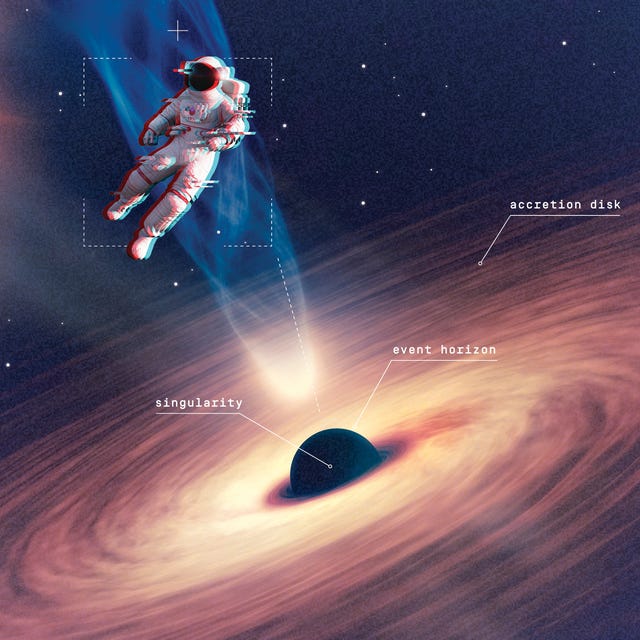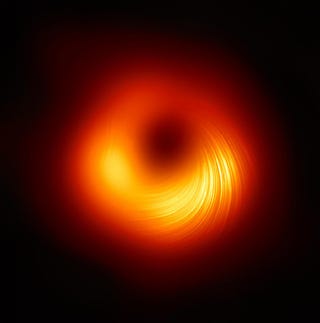Our understanding of black holes has exploded in recent years, with landmark works like the photograph of the Messier 87 galaxy’s supermassive black hole and the recent discovery of a “tiny” three-sun-mass black hole in our own galaxy. But what would it be like to make the next leap: to visit—and even enter—a black hole? We asked the experts.
First, to survive long enough to explore a black hole, you must find a big one, says Janna Levin, Ph.D., an astrophysicist at Barnard College of Columbia University. Black holes form when matter condenses into a tiny amount of space, like when a massive star collapses in on itself. This creates a point of infinitely strong gravity—a singularity—and a surrounding region that traps anything that wanders too close, called the event horizon.
As matter gets packed into a black hole’s central singularity, its event horizon grows. This means if you hopped into a small black hole—say, 100 miles across—you’d enter relatively close to its point of infinite gravity. The change in gravity even before the event horizon would be so steep that you’d get steadily stretched from head to toe in a process irreverently called spaghettification.
Instead, you should aim for a supermassive black hole, like the one within M87, which is over 3 million times wider than Earth. You’d be so far from the singularity when you crossed the event horizon—about 12 billion miles—that it would be “as unspectacular as stepping into the shadow of a tree,” Levin says. You would simply float across, and keep floating, for a while. In the biggest black holes, Levin adds, “you might be able to make it for a year before you are ultimately demolished in the center.”
Next, avoid black holes with accretion disks. About 1 percent of supermassive black holes accumulate these fast-spinning rings of matter. They can heat up to millions of degrees and create “some of the largest magnetic fields that we’ve measured,” says Leo Rodriguez, Ph.D., a theoretical physicist at Grinnell College in Iowa. Magnetic fields this strong would shut down your nervous system and stretch your atoms into skinny rods until you dissolve. But if pressed for options, says Levin, you could attempt to enter one of these black holes perpendicular to the disk, far from the edge of the fiery ring.
So, How Do Scientists Really Study Black Holes?
The groundbreaking snapshot of M87*, the supermassive black hole at the center of the M87 galaxy about 55 million light-years away from Earth, was a product of the Event Horizon Telescope, an international collaboration between over 200 researchers. Using a technique called very long baseline interferometry, eight synchronized ground-based radio observatories around the world formed, in essence, one Earth-sized radio telescope powerful enough to make high-resolution observations roughly 4,000 times those of the Hubble Space Telescope.
The team recently released additional images (see above) that reveal the pace at which M87* gobbles up its surroundings and display the web-like structure of magnetic field lines, which swirl around the black hole and shape massive jets of energetic particles emanating from its center.
— Jennifer Leman
If you’re still uneasy about crossing over into (almost) certain oblivion, you can also probe the black hole’s ergosphere. This is the region just outside the event horizon where space itself spins with the black hole. “People have theorized that you could probably have entire solar systems living inside this area,” Rodriguez says. At this point, you could still attempt a grand escape. By throwing, say, a small asteroid into a black hole, you could steal some of the black hole’s spin energy and get “slingshotted” to safety, Rodriguez says.
If you’ve steeled yourself for the big plunge, you’re in for a spectacular show. As you approach the black hole, you’ll see the light of the universe warped by the black hole’s intense gravity. “It will be like crossing into a funhouse mirror,” Levin says. The light from stars will smear across the sky, and you may see copies of the same objects as the black hole bends the light that bounces off them. But the light show doesn’t end there. The inside of a black hole isn’t black. Instead, it’s a one-way window to the universe that contains eons of trapped light. “You would be able to see an entire history of the black hole since it was formed,” Rodriguez says.
Time slows near a black hole’s intense gravity. To the outside world, you’ve slowed so much that you’re a frozen image on the event horizon, even though you’re already inside. But from your perspective, the motion of the universe has accelerated. If you look back out as you float toward the singularity, you may see the universe zip by without you. “You would be watching the film of the entire galaxy unfold in front of you before you died,” Levin says.
There is still one potential exit, but it lies in a far-afield realm of theoretical physics. Your black hole could double as a wormhole, transporting you to another part of the universe—albeit disintegrated into your most elementary particles, says Levin. “All you can really hope for is that your quantum information will make it out of the black hole, and some kind soul will spend an eternity reassembling the biological machine that was you.”














